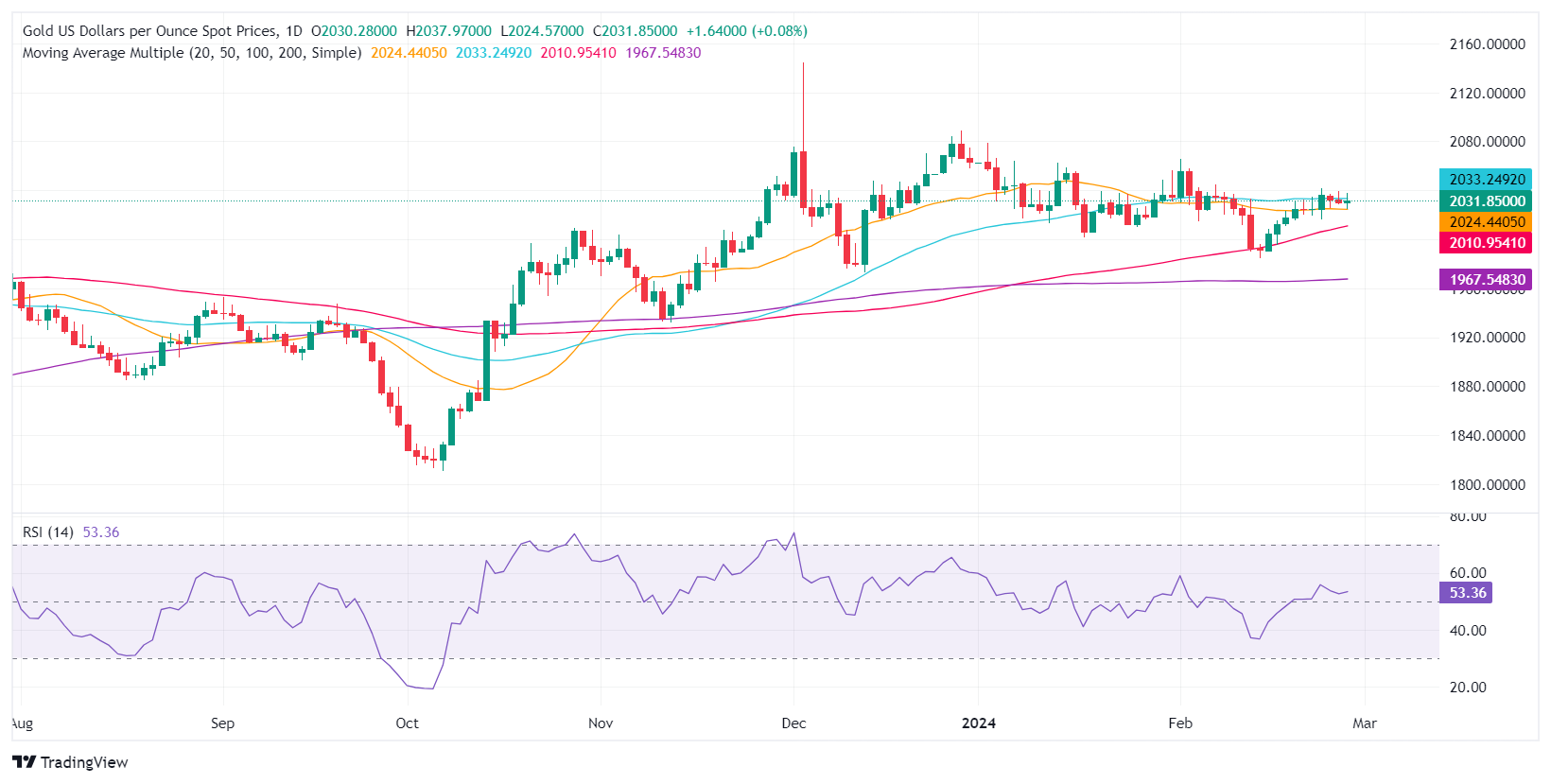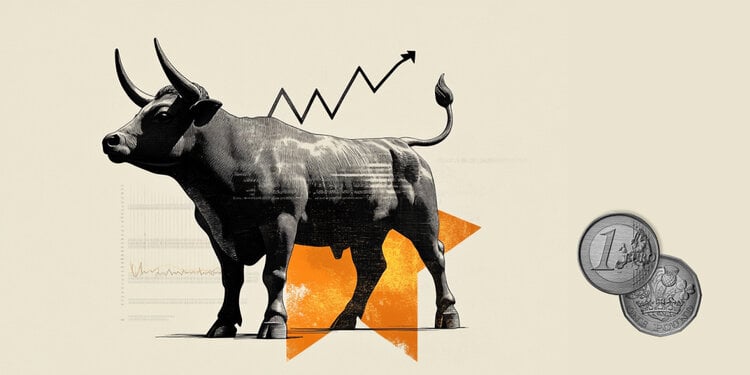- Gold remains at $2,030, buoyed by falling US Treasury yields and recent economic growth figures.
- Mixed US economic indicators and Fed statements on monetary policy easing keep Gold investors alert.
- The 50-day SMA caps Gold's gains as Wall Street indices reflect a cautious sentiment in the market.
The price of Gold remains steady near $2,030 on Wednesday, posting a 0.17% gain after the US Bureau of Economic Analysis (BEA) revealed that the country's economy expanded. Falling US Treasury yields have kept the yellow metal near the current monthly and weekly highs, topped by the 50-day simple moving average (SMA).
On Wall Street, most indices are trading lower. Gross Domestic Product (GDP) for the final quarter of 2023 expanded slightly below the consensus and preliminary reading, while retail and wholesale inventories were mixed.
Federal Reserve (Fed) regional presidents Susan Collins and John Williams will give remarks. They repeated previous comments about easing monetary policy at the end of the year and stressed that they have not met the 2% target for core inflation.
Daily summary of market movements: Gold rises on falling US yields
- Boston Fed President Susan Collins said: “I think it will probably be appropriate to begin easing monetary policy later this year,” adding: “When that happens, a methodical and forward-looking approach of gradually reducing “rates should provide the flexibility necessary to manage risks while promoting price stability and maximum employment.”
- New York Fed President John Williams stated, “While the economy has come a long way toward achieving greater equilibrium and reaching our 2% inflation goal, we are not there yet,” adding that he would have We must evaluate “the data, the economic outlook and the risks, when assessing the appropriate path for monetary policy that best achieves our objectives.”
- On Tuesday, Federal Reserve Governor Michelle Bowman said she is in no rush to cut rates, given the upside risks to inflation that could slow progress or cause renewed price pressure.
- Bowman said inflation would decline “slowly,” adding that she would remain “cautious in my approach when considering future changes in policy direction.”
- The Gross Domestic Product (GDP) for the last quarter of 2023 stood at 3.2% year-on-year, slightly below the preliminary estimate of 3.3%.
- U.S. retail sales inventories rose 0.3% mom in January, down from 0.4% in the previous month, while wholesale inventories fell -0.1% mom, below estimates of 0.1%.
- Previous data published in the week:
- Durable goods orders in the United States fell -6.1% month-on-month, above the -4.5% contraction expected and the -0.3% drop seen in December.
- The S&P/Case Shiller Home Price Index for December rose 6.1% year over year, beating estimates of 6% and November's reading of 5.4%.
- New home sales in the United States rose 1.5%, from 0.651 million to 0.661 million, less than the 0.68 million expected.
- The Dallas Fed manufacturing index for February contracted -11.3, although it improved compared to January's -27.4 contraction, suggesting that business activity is recovering.
- The Dollar Index (DXY), which measures the value of the greenback against six major currencies, rises to 103.95, as uncertainty over US economic data has increased the attractiveness of safe-haven assets.
- The yield on the 10-year US Treasury bond is at 4.284%, down two basis points.
- Interest rate speculators have ruled out a Fed rate cut in March and May. For June, the odds of a 25 basis point rate cut stand at 49.7%.
- Investors expect an easing of 85 basis points throughout 2024.

Gold is trading sideways as XAU/USD has failed to break above the $2,035 psychological resistance level over the last 12 days. However, the bullish bias remains intact, and if buyers reclaim the $2,035 level, that could open the door to challenge the psychological figure of $2,050. The next key resistance levels would be the February 1 high at $2,065.60, ahead of the December 28 high at $2,088.48.
On the other hand, if Gold falls below the February 16 low of $2,016.15, XAU/USD would sink towards the October 27 daily high of $2,009.42. Once broken, it would expose key technical support levels such as the 100-day SMA at $2,009.42, followed by the 200-day SMA at $1,967.45.
Frequently asked questions about Gold
Why invest in Gold?
Gold has played a fundamental role in human history, as it has been widely used as a store of value and medium of exchange. Today, aside from its brilliance and use for jewelry, the precious metal is considered a safe-haven asset, meaning it is considered a good investment in turbulent times. Gold is also considered a hedge against inflation and currency depreciation, since it does not depend on any specific issuer or government.
Who buys more Gold?
Central banks are the largest holders of Gold. In their aim to support their currencies in turbulent times, central banks tend to diversify their reserves and purchase Gold to improve the perception of strength of the economy and currency. High Gold reserves can be a source of confidence for the solvency of a country. Central banks added 1,136 tons of gold worth about $70 billion to their reserves in 2022, according to data from the World Gold Council. This is the largest annual purchase since records exist. Central banks in emerging economies such as China, India and Turkey are rapidly increasing their gold reserves.
What correlation does Gold have with other assets?
Gold has an inverse correlation with the US Dollar and US Treasuries, which are the main reserve and safe haven assets. When the Dollar depreciates, the price of Gold tends to rise, allowing investors and central banks to diversify their assets in turbulent times. Gold is also inversely correlated with risk assets. A rally in the stock market tends to weaken the price of Gold, while sell-offs in riskier markets tend to favor the precious metal.
What does the price of Gold depend on?
The price of Gold can move due to a wide range of factors. Geopolitical instability or fear of a deep recession can cause the price of Gold to rise rapidly due to its status as a safe haven asset. As a non-yielding asset, the price of Gold tends to rise when interest rates fall, while rising money prices tend to weigh down the yellow metal. Still, most of the moves depend on how the US Dollar (USD) performs, as the asset is traded in dollars (XAU/USD). A strong Dollar tends to keep the price of Gold in check, while a weaker Dollar is likely to push up Gold prices.
Source: Fx Street
I am Joshua Winder, a senior-level journalist and editor at World Stock Market. I specialize in covering news related to the stock market and economic trends. With more than 8 years of experience in this field, I have become an expert in financial reporting.







